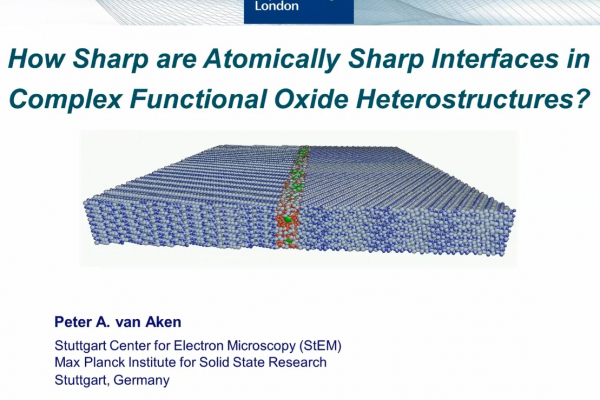Peter A. van Aken’s lecture at the Imperial College London on “How Sharp are Atomically Sharp Interfaces in Complex Functional Oxide Heterostructures?”

Peter A. van Aken from the Stuttgart Center for Electron Microscopy (StEM) at the Max Planck Institute for Solid State Research (Stuttgart, Germany) presented a lecture on “How Sharp are Atomically Sharp Interfaces in Complex Functional Oxide Heterostructures?” to the Imperial College London on 20th January 2021.
Abstract
Complex functional oxide heterostructures have been serving as a multi-directional platform for engineering novel interface functionalities. Recent technical improvements of the epitaxial growth techniques enable fabricating high-quality thin films and heterostructures. The phenomena occurring at their interfaces can be tailored depending on the choice of the constituents. However, the key factor dominating the interface functionalities is the control of interface sharpness. Perfect epitaxial grown and structurally sharp interfaces may be rough with respect to its corresponding chemical composition. Therefore, examining the interfacial structure and chemistry is vital for correlating with the physical properties.
In this lecture, Peter A. van Aken present investigations on various complex functional oxide heterostructures exhibiting different interface sharpness and, correlatively, different functionalities. Some exciting findings demonstrate the following: i) The growth technique, i.e. pulsed-laser deposition versus atomic layer-by-layer oxide molecular beam epitaxy, has a direct impact on the structural and chemical sharpness of the interfaces, ii) two-dimensional doping of La2CuO4-based multilayers results in different dopant distributions at both sides of the interfaces, which induce different superconducting mechanisms, iii) the choice of the dopant directly affects the interface sharpness, namely, dopant re-distribution, local octahedral distortions and thereby the interface functionalities. The effect of dopant distribution at interfaces on physical properties will be discussed.
To resume this presentation, the programme is as below:
1) Introduction and methods;
2) Sample-related interface broadening;
3) Detection-related delocalization effects;
4) Summary.
Furthermore, a presentation of the different ESTEEM projects had been acknowledged and specifically the current one: ESTEEM3. With a brief presentation of the different activities of the projects, from the transnational activities to the joint research activities or the networking activities.
Further details here.
Watch the replay in our "Lecture" section.
